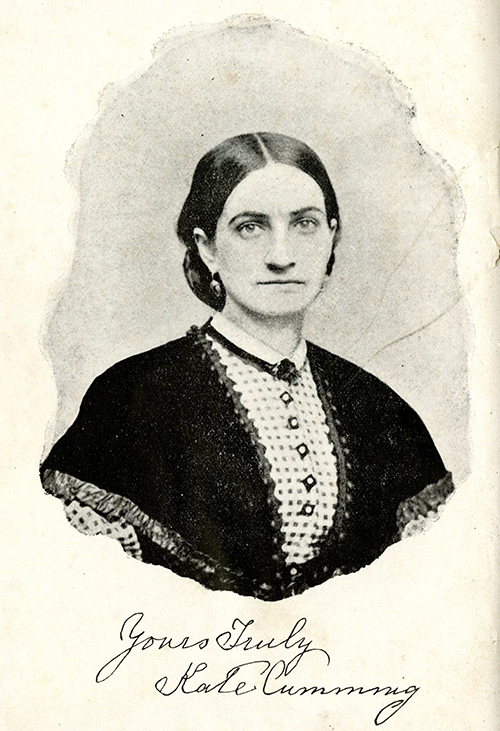A journal of hospital life in the Confederate Army of Tennessee, from the battle of Shiloh to the end of the war: with sketches of life and character... Louisville, KY: John P. Morton & Co., c1866.
 One of the very few accounts of the work of Confederate women during the Civil War is Kate Cumming’s A journal of hospital life in the Confederate Army of Tennessee. A copy of this journal, published in 1866, is held at the Reynolds-Finley Historical Library. It provides us with extensive knowledge of the role of women in Confederate hospitals, written from the perspective of a woman who served in a nursing capacity from 1862-1865. It is also the most complete and detailed narrative of Confederate hospital life known (Harwell xv-xvi).
One of the very few accounts of the work of Confederate women during the Civil War is Kate Cumming’s A journal of hospital life in the Confederate Army of Tennessee. A copy of this journal, published in 1866, is held at the Reynolds-Finley Historical Library. It provides us with extensive knowledge of the role of women in Confederate hospitals, written from the perspective of a woman who served in a nursing capacity from 1862-1865. It is also the most complete and detailed narrative of Confederate hospital life known (Harwell xv-xvi).
Kate Cumming was born in Scotland and, as a child, moved to America with her large family, first to Montreal, then to New York, and finally in the 1840’s to Mobile, Alabama. There she spent the remainder of her youth and early adulthood. By the 1860s, Cumming had been in the South for many years and identified the Confederacy as home and “the cause” as her own (Heidler & Heidler 5: 528-529). Several months after the start of the Civil War, Kate was much inspired by an address given by family friend, Reverend Benjamin M. Miller, at a local church. In his speech, Miller called for Southern ladies to help the wounded and sick by becoming nurses at the war front. Cumming was discouraged from volunteering by her respectable Southern family, who thought that “nursing soldiers was no work for a refined lady,” (qtd. in Harwell x). Therefore, initially she relegated her involvement to assisting other volunteers in their preparation to leave for the hospitals. However, when a regiment of old school and church friends were sent off to war, Cumming was compelled to offer her services to Mr. Miller despite her family’s disapproval and her own lack of hospital training. In April of 1862, Mr. Miller summoned his volunteer ladies to head north to Mississippi to help those returning from the battle at Shiloh (Harwell x).
Conditions in the hospitals of Okolona and Corinth, Mississippi were so horrible that only Cumming and one other nurse stayed beyond a week. Despite the hardships, Kate remained through June and returned to serve in Chattanooga that fall. Her duties were many faceted — delivering food and medicine, managing laundresses, writing letters, keeping clothing and bedding fresh, and even cooking (Heidler & Heidler 5: 529). In September of 1862, new laws allowed the employment of women to be officially recognized by the Confederate medical department, and at that time, Cumming received the rank of matron, or hospital supervisor (Notable American Women). She worked in Chattanooga until the summer of 1863, and then traveled with Surgeon Samuel Stout’s medical corps in the Army of Tennessee, which was constantly moving as General Sherman swept through Georgia and the Carolinas (Heidler & Heidler 5: 529). Stout was first hesitant to accept the role of women in the hospital, but was soon convinced, and commended them in his personal narrative. He specifically names Cumming and two others as “the first refined, intellectual, self-denying ladies, who in the midst of the suffering soldiers, served at their bunkside at night as well as day. Their self-denying and heroic benevolence inspirited many other educated and refined ladies to imitate their examples,” (qtd. in Harwell xii).
While traveling with the Army of Tennessee, Cumming faithfully recorded her experiences in a journal, which became her great contribution to history. Hastily published within a year of her return to Mobile after the war, Kate Cumming’s journal did not receive the readership it deserved, perhaps because it was too close to the events or because of the influx of Confederate narratives at the time (Harwell xv). However, the journal is invaluable from a historical perspective because it is the most complete and realistic record of the workings of Confederate hospitals and the services of matrons. Later, in 1890, she republished the journal under the title, Gleanings from Southland. This shortened, edited version experienced more success in a market “hungry for ‘the romance of reunion’” (Heidler & Heidler 5: 529). Cumming moved to Birmingham in 1874, where she remained until her death in 1909.
Image: Kate Cumming, Gleanings from Southland (1895), Reynolds-Finley Historical Library.
